Python Programming - IV. Program Components (Functions, Classes, Modules, Packages)
15 likes7,173 views
Feel free to download the material for offline viewing later, better images' resolutions, and crispier fonts.
1 of 84
Downloaded 943 times
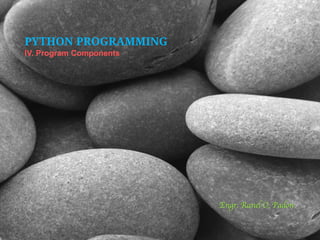
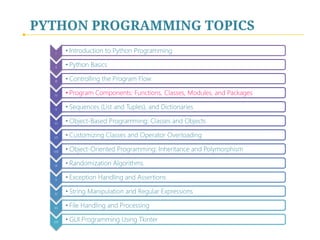



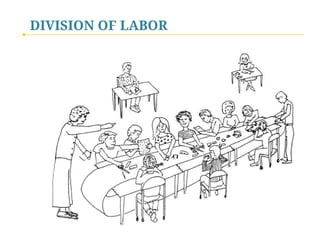
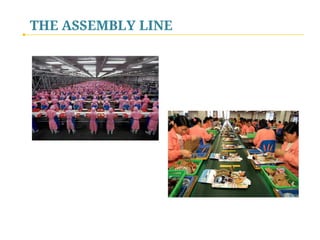
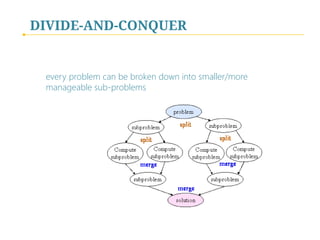

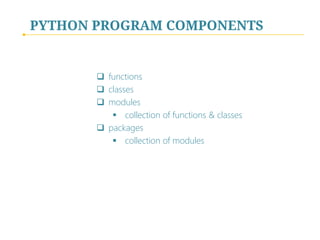
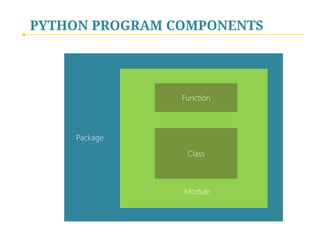
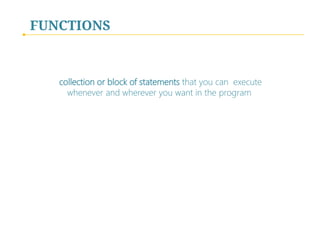


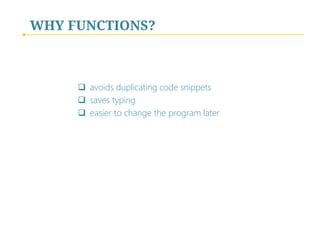


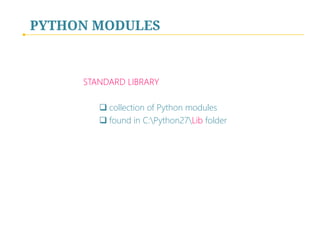

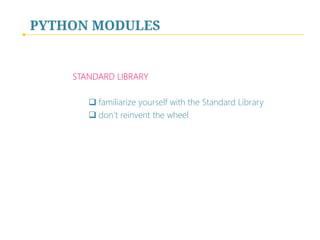


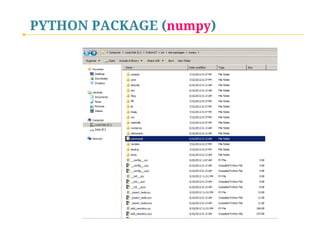
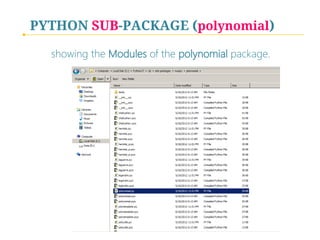
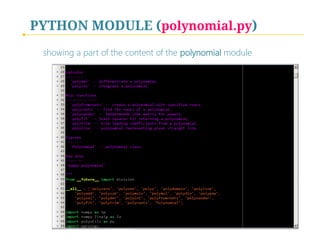
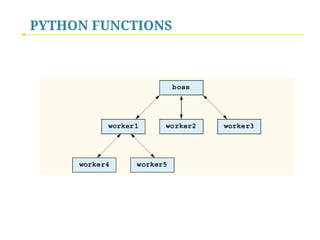
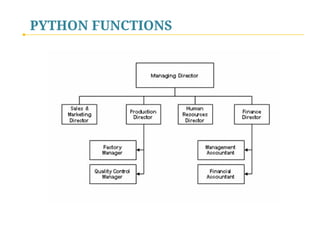

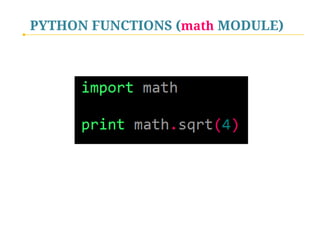
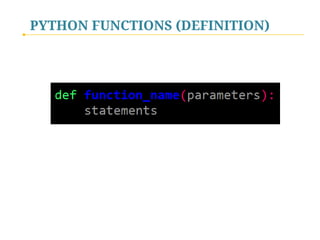
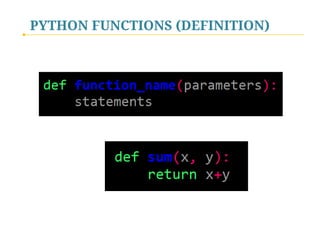
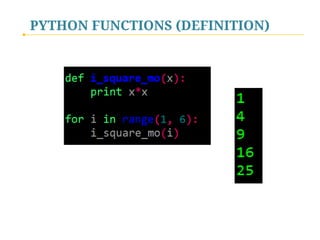
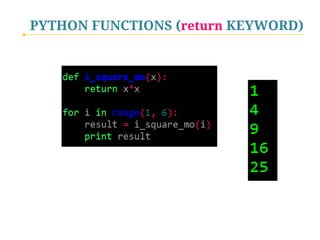
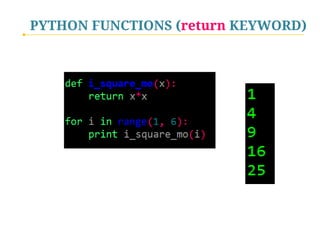
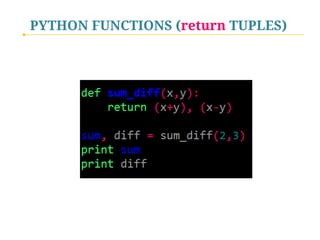
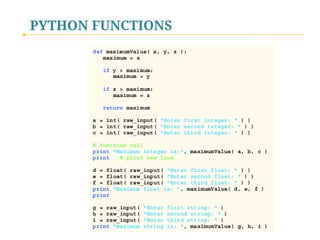

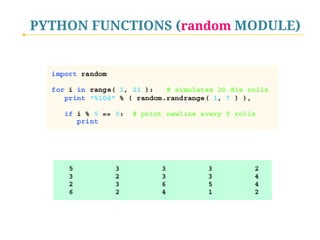

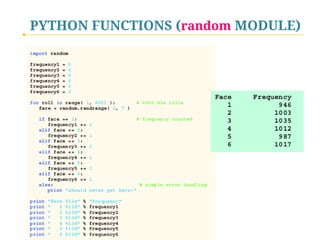
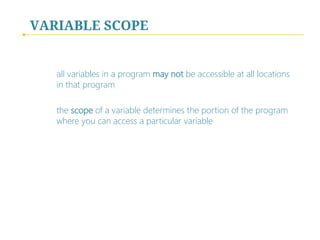
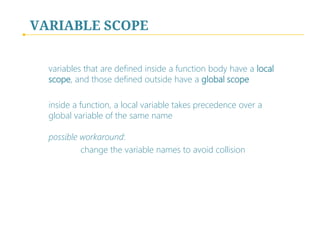
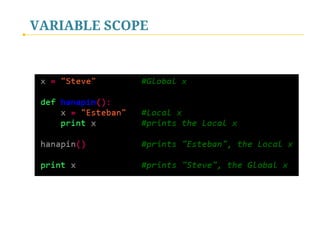
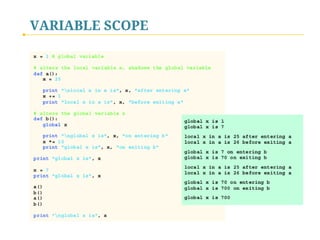
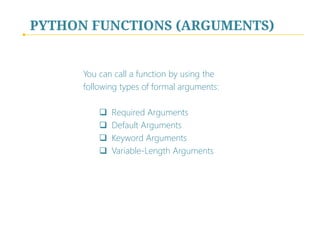
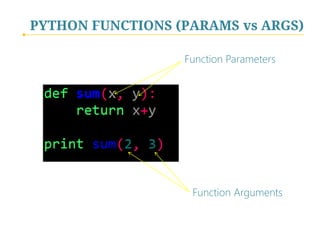
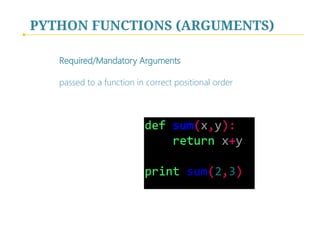
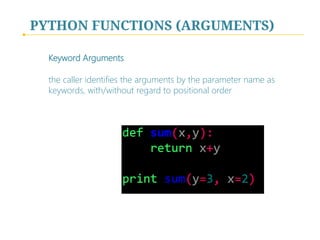
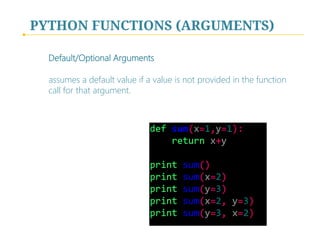
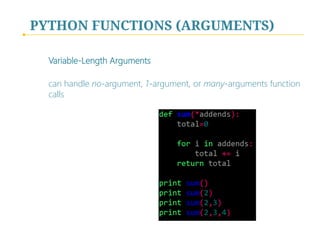
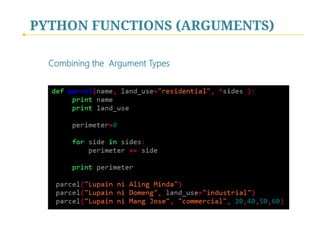

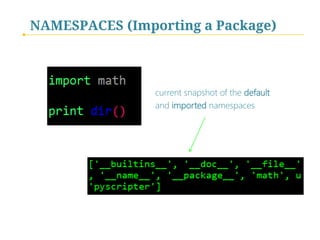
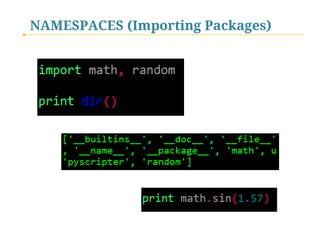
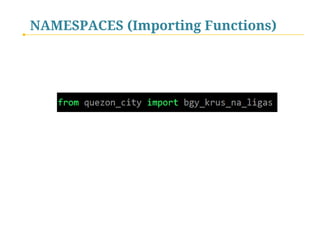
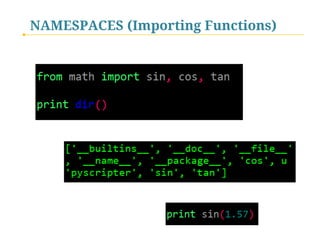

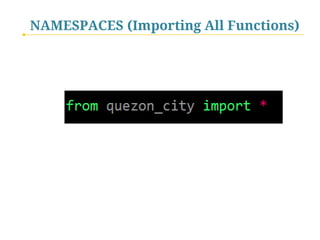

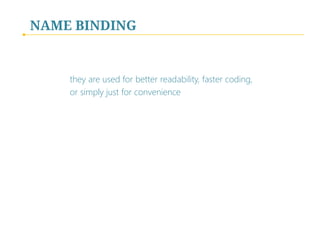

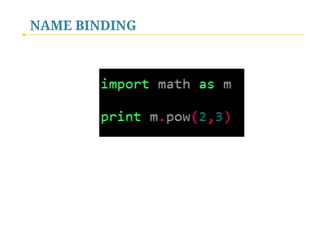
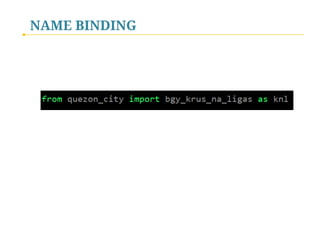
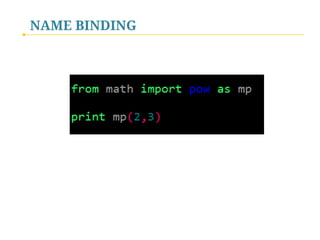
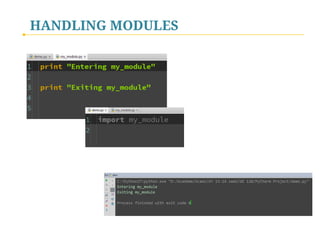
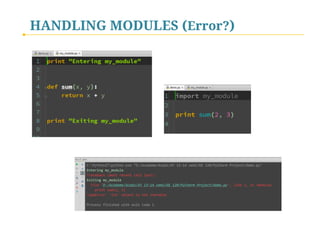
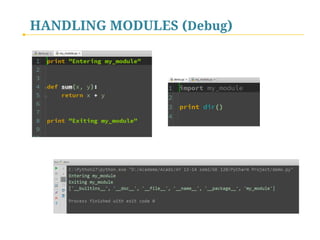
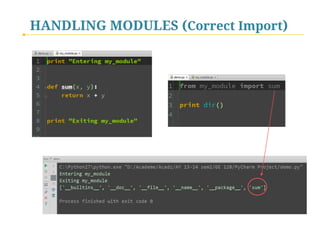
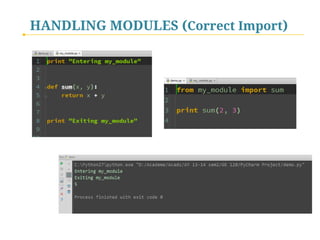
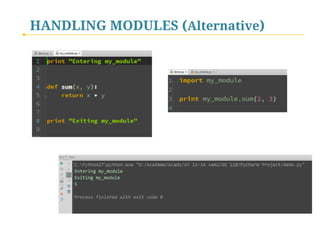

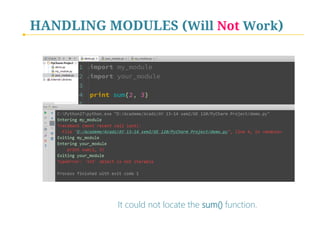
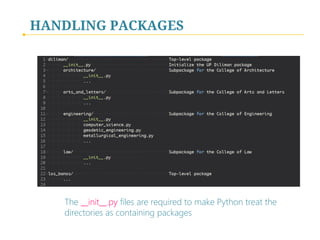
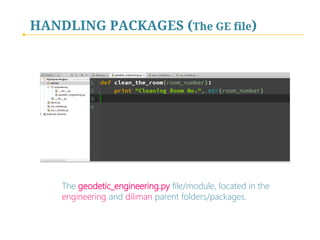
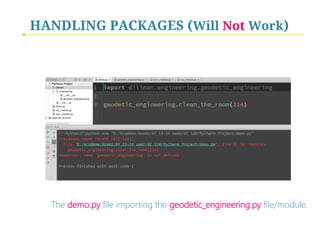

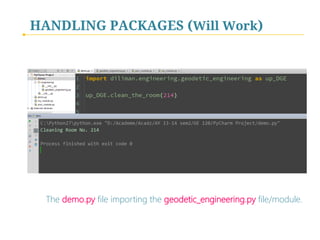
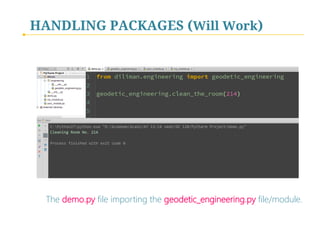
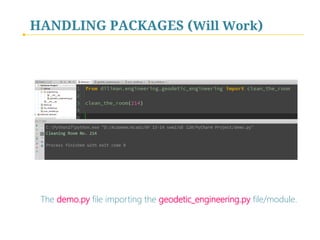
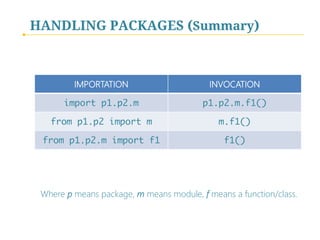


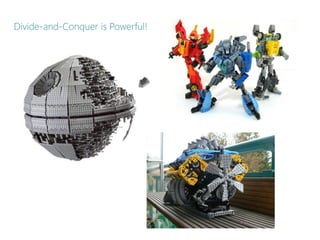

Ad
Recommended
Python Programming - XII. File Processing



Python Programming - XII. File ProcessingRanel Padon The document discusses file handling and processing in Python. It covers opening and closing files, different file open modes like read, write and append, parsing files, buffering, and random access files. Common file operations like reading, writing, splitting and stripping file contents are demonstrated. The document also provides examples of parsing HTML and CSV files, using files with classes, and serializing objects for efficient storage and transfer.
Object-oriented Programming in Python



Object-oriented Programming in PythonJuan-Manuel Gimeno This document outlines an introduction to object oriented programming in Python. It discusses Python's support for multiple programming paradigms including procedural, object-oriented, and functional. Python allows programmers to choose the paradigm best suited to the problem. The document then covers Python classes, stating that a class is a Python object that returns a new instance when called. Classes contain attributes that can be descriptors like functions or normal data. Inheritance allows classes to delegate attribute lookup to parent classes.
Chapter 03 python libraries



Chapter 03 python librariesPraveen M Jigajinni Python modules allow for code reusability and organization. There are three main components of a Python program: libraries/packages, modules, and functions/sub-modules. Modules can be imported using import, from, or from * statements. Namespaces and name resolution determine how names are looked up and associated with objects. Packages are collections of related modules and use an __init__.py file to be recognized as packages by Python.
Functional Programming You Already Know - Kevlin Henney - Codemotion Rome 2015



Functional Programming You Already Know - Kevlin Henney - Codemotion Rome 2015Codemotion From JVM to .NET languages, from minor coding idioms to system-level architectures, functional programming is enjoying a long overdue surge in interest. Functional programming is certainly not a new idea and, although not apparently as mainstream as object-oriented and procedural programming, many of its concepts are also more familiar than many programmers believe. This talk examines functional and declarative programming styles from the point of view of coding patterns, little languages and programming techniques already familiar to many programmers.
11 Unit 1 Chapter 02 Python Fundamentals



11 Unit 1 Chapter 02 Python FundamentalsPraveen M Jigajinni This document provides an introduction to Python fundamentals. It discusses Python's character set, tokens or lexical units including keywords, identifiers, literals, operators, and punctuators. It also covers Python programming concepts such as variables and assignments, functions, comments, statements, and programming conventions regarding whitespace, maximum line length, and case sensitivity. The document aims to explain the basic building blocks of the Python language to learn Python programming.
Python Advanced – Building on the foundation



Python Advanced – Building on the foundationKevlin Henney This is a two-day course in Python programming aimed at professional programmers. The course material provided here is intended to be used by teachers of the language, but individual learners might find some of this useful as well.
The course assume the students already know Python, to the level taught in the Python Foundation course: http://www.slideshare.net/Kevlin/python-foundation-a-programmers-introduction-to-python-concepts-style)
The course is released under Creative Commons Attribution 4.0. Its primary location (along with the original PowerPoint) is at https://github.com/JonJagger/two-day-courses/tree/master/pa
Chapter 05 classes and objects



Chapter 05 classes and objectsPraveen M Jigajinni Here is a Python class with the specifications provided in the question:
class PICTURE:
def __init__(self, pno, category, location):
self.pno = pno
self.category = category
self.location = location
def FixLocation(self, new_location):
self.location = new_location
This defines a PICTURE class with three instance attributes - pno, category and location as specified in the question. It also defines a FixLocation method to assign a new location as required.
Chapter 06 constructors and destructors



Chapter 06 constructors and destructorsPraveen M Jigajinni Constructors and destructors in Python.
Constructors are special methods that are called automatically when an object is created. They initialize variables and ensure objects are properly initialized. There are two types of constructors: default and parameterized. Default don't take arguments, parameterized do.
Destructors are called when an object is destroyed. Defined using __del__(), they are useful for releasing resources like closing files before a program exits.
The document then provides code examples of classes with constructors, parameterized constructors, and destructors. It also discusses Python's garbage collection and how the collector deletes unneeded objects to free memory space.
Python Programming - VI. Classes and Objects



Python Programming - VI. Classes and ObjectsRanel Padon This document discusses classes and objects in Python programming. It covers key concepts like class attributes, instantiating classes to create objects, using constructors and destructors, composition where objects have other objects as attributes, and referencing objects. The document uses examples like a Time class to demonstrate class syntax and how to define attributes and behaviors for classes.
Introduction to c ++ part -2



Introduction to c ++ part -2baabtra.com - No. 1 supplier of quality freshers This document discusses file handling in C++. It introduces three classes - ofstream, ifstream, and fstream - that allow performing output and input of characters to and from files. The ofstream class is used to write to files, ifstream is used to read from files, and fstream can both read and write. The open() method is used to open a file, specifying the file name and optional file mode. Writing to a file uses the << operator and reading uses the >> operator. Operator overloading allows user-defined types like classes to define the meaning of operators like + when used on their objects.
Solid Deconstruction



Solid DeconstructionKevlin Henney Presented at DevSum (2018-05-31)
The SOLID principles are often presented as being core to good code design practice. Each of S, O, L, I and D do not, however, necessarily mean what programmers expect they mean or are taught. By understanding this range of beliefs we can learn more about practices for objects, components and interfaces than just S, O, L, I and D.
This talk reviews the SOLID principles and reveals contradictions and different interpretations. It is through paradoxes and surprises we often gain insights. We will leave SOLID somewhat more fluid, but having learnt from them more than expected.
Python Functions Tutorial | Working With Functions In Python | Python Trainin...



Python Functions Tutorial | Working With Functions In Python | Python Trainin...Edureka! ** Python Certification Training: https://www.edureka.co/python **
This Edureka PPT on Python Functions tutorial covers all the important aspects of functions in Python right from the introduction to what functions are, all the way till checking out the major functions and using the code-first approach to understand them better.
Agenda
Why use Functions?
What are the Functions?
Types of Python Functions
Built-in Functions in Python
User-defined Functions in Python
Python Lambda Function
Conclusion
Python Tutorial Playlist: https://goo.gl/WsBpKe
Blog Series: http://bit.ly/2sqmP4s
Follow us to never miss an update in the future.
Instagram: https://www.instagram.com/edureka_learning/
Facebook: https://www.facebook.com/edurekaIN/
Twitter: https://twitter.com/edurekain
LinkedIn: https://www.linkedin.com/company/edureka
Functions and modules in python



Functions and modules in pythonKarin Lagesen The document discusses functions, modules, and how to modularize Python programs. It provides examples of defining functions, using parameters, returning values, and function scope. It also discusses creating modules, importing modules, and the difference between running a Python file as a module versus running it as the main script using the __name__ == "__main__" check. The key points are that functions help break programs into reusable and readable components, modules further help organize code, and the __name__ check allows code to run differently depending on how it is imported or run directly.
Python Interview Questions For Experienced



Python Interview Questions For Experiencedzynofustechnology The document provides information about various Python concepts like PEP 8, pickling, lambda functions, generators, modules, packages and more. It also includes questions about memory management in Python, tools for static analysis, decorators, iterators, slicing, and other common Python interview questions.
CLASS OBJECT AND INHERITANCE IN PYTHON



CLASS OBJECT AND INHERITANCE IN PYTHONLalitkumar_98 This document discusses classes, objects, and inheritance in Python. It defines a class as a blueprint for creating objects, with objects being instances of a class. It describes how to define a class in Python using the class keyword and how to create object instances from a class. The document also explains inheritance in Python, where a derived or child class can inherit attributes and methods from a parent or base class, allowing for single, multiple, multilevel, hybrid and hierarchical inheritance.
A COMPLETE FILE FOR C++



A COMPLETE FILE FOR C++M Hussnain Ali This document provides an overview of object-oriented programming concepts in C++, including classes, objects, encapsulation, inheritance, polymorphism, and more. Key concepts are defined, such as classes containing data members and methods. Inheritance allows derived classes to inherit properties of base classes. Polymorphism allows calling the correct overridden method at runtime based on the object type. Virtual functions provide late binding so the correct derived class method is called.
Object-Oriented Programming Using C++



Object-Oriented Programming Using C++Salahaddin University-Erbil This is also from Mr Karim Zebari for OOP programming. Its better to start with simple principals of C++ programming before starting this one.
Programming in c++



Programming in c++Baljit Saini This document outlines the course content for a Programming in C++ course, including 12 topics that will be covered: 1) principles of object oriented programming, 2) beginning with C++, 3) tokens, expressions, and control structures, 4) functions in C++, 5) classes and objects, 6) constructors and destructors, 7) operator overloading and type conversions, 8) inheritance, 9) pointers, virtual functions and polymorphism, 10) managing console I/O operations, 11) working with files, and 12) templates and exception handling. Students will write programs based on the curriculum and six reference books are provided.
Object oriented concepts



Object oriented conceptsPranali Chaudhari Object-oriented programming focuses on data. An object is a basic run-time entity. A class is also known as a user-defined data type. Inheritance provides the idea of reusability. Objects can communicate with each other through message passing. Polymorphism is achieved through operator overloading and function overloading.
Python interview questions and answers



Python interview questions and answersRojaPriya The document discusses Python interview questions and answers related to Python fundamentals like data types, variables, functions, objects and classes. Some key points include:
- Python is an interpreted, interactive and object-oriented programming language. It uses indentation to identify code blocks rather than brackets.
- Python supports dynamic typing where the type is determined at runtime. It is strongly typed meaning operations inappropriate for a type will fail with an exception.
- Common data types include lists (mutable), tuples (immutable), dictionaries, strings and numbers.
- Functions use def, parameters are passed by reference, and variables can be local or global scope.
- Classes use inheritance, polymorphism and encapsulation to create
File handling & regular expressions in python programming



File handling & regular expressions in python programmingSrinivas Narasegouda The document discusses file handling and regular expressions in Python programming. It covers opening, reading, and writing files in both text and binary modes. It also describes parsing text files using built-in functions and regular expressions. Regular expressions topics covered include characters, character classes, quantifiers, grouping, capturing, assertions, and flags. The document provides examples of using the re module to search and manipulate strings using regular expression patterns.
C++ Object oriented concepts & programming



C++ Object oriented concepts & programmingnirajmandaliya This document discusses various C++ concepts related to functions and operators. It defines what a default pointer is and how it receives addresses passed to a called function. It also discusses reference variables, inline functions, friend functions, default arguments, passing objects as parameters, function overloading, static members, function pointers, and operator overloading. It provides examples and explanations for each concept.
Python and You Series



Python and You SeriesKarthik Prakash The document provides an introduction to the Python programming language. It discusses what Python is, its creator Guido van Rossum, and how to write a simple "Hello World" program. It also covers Python data types, operators, flow control using conditionals and loops, functions, input/output operations, and the Zen of Python philosophy guiding Python's design. The document serves as the first day of instruction in a Python course.
Object-oriented Programming-with C#



Object-oriented Programming-with C#Doncho Minkov The document discusses object-oriented programming concepts in C#, including defining classes, constructors, properties, static members, interfaces, inheritance, and polymorphism. It provides examples of defining a simple Cat class with fields, a constructor, properties, and methods. It also demonstrates using the Dog class by creating dog objects, setting their properties, and calling their bark method.
Python revision tour i



Python revision tour iMr. Vikram Singh Slathia Computer Science with Python
Class XII
Unit I: Computational Thinking and Programming -2
Chapter 1: Review of Python basics I (Revision Tour Class XI)
Chapter 07 inheritance



Chapter 07 inheritancePraveen M Jigajinni 1. Inheritance is a mechanism where a new class is derived from an existing class, known as the base or parent class. The derived class inherits properties and methods from the parent class.
2. There are 5 types of inheritance: single, multilevel, multiple, hierarchical, and hybrid. Multiple inheritance allows a class to inherit from more than one parent class.
3. Overriding allows a subclass to replace or extend a method defined in the parent class, while still calling the parent method using the super() function or parent class name. This allows the subclass to provide a specific implementation of a method.
Python Session - 2



Python Session - 2AnirudhaGaikwad4 Python Session - 2
Install Python
Run Python
Python Keyword
Python Identifiers
Python Variables
Python Literals
Python Comments
By default Python installed on following path in Windows
C:\Users\user\AppData\Local\Programs\Python\Python37
Removing the MAX_PATH Limitation :
Windows historically has limited path lengths to 260 characters. This meant that paths longer than this would not resolve and errors would result.
In the latest versions of Windows, this limitation can be expanded to approximately 32,000 characters. Your administrator will need to activate the “Enable Win32 long paths” group policy, or set the registry value HKEY_LOCAL_MACHINE\SYSTEM\CurrentControlSet\Control\FileSystem@LongPathsEnabled to 1.
Oop c++class(final).ppt



Oop c++class(final).pptAlok Kumar This document provides an overview of object-oriented programming concepts using C++. It discusses key OOP concepts like objects, classes, encapsulation, inheritance, polymorphism, and dynamic binding. It also covers C++ specific topics like functions, arrays, strings, modular programming, and classes and objects in C++. The document is intended to introduce the reader to the fundamentals of OOP using C++.
Python Programming - XI. String Manipulation and Regular Expressions



Python Programming - XI. String Manipulation and Regular ExpressionsRanel Padon The document discusses string manipulation and regular expressions in Python programming. It covers topics like string methods, regular expression concepts including alternatives, grouping, quantification, anchors, meta-characters and character classes. Examples are provided to demonstrate matching patterns in text using regular expressions. The re module is introduced as the core module for using regular expressions in Python.
Python Programming - XIII. GUI Programming



Python Programming - XIII. GUI ProgrammingRanel Padon The document discusses Tkinter, the Python GUI programming interface. Tkinter provides a wrapper for the Tk GUI toolkit. Tk was originally created for Tcl but has bindings for other languages like Python through Tkinter. Tkinter allows Python programs to create graphical user interfaces by providing classes and methods that interface with the Tk GUI toolkit. Some key Tkinter widgets discussed include Frame, Label, Button, Entry, Radiobutton and Checkbutton. Pros of Tkinter include brevity, cross-platform support, maturity and extensibility. Potential cons are that it relies on Tcl/Tk which some consider unnecessary and it may have a theoretical speed disadvantage due to the multiple layers of interpretation.
More Related Content
What's hot (20)
Python Programming - VI. Classes and Objects



Python Programming - VI. Classes and ObjectsRanel Padon This document discusses classes and objects in Python programming. It covers key concepts like class attributes, instantiating classes to create objects, using constructors and destructors, composition where objects have other objects as attributes, and referencing objects. The document uses examples like a Time class to demonstrate class syntax and how to define attributes and behaviors for classes.
Introduction to c ++ part -2



Introduction to c ++ part -2baabtra.com - No. 1 supplier of quality freshers This document discusses file handling in C++. It introduces three classes - ofstream, ifstream, and fstream - that allow performing output and input of characters to and from files. The ofstream class is used to write to files, ifstream is used to read from files, and fstream can both read and write. The open() method is used to open a file, specifying the file name and optional file mode. Writing to a file uses the << operator and reading uses the >> operator. Operator overloading allows user-defined types like classes to define the meaning of operators like + when used on their objects.
Solid Deconstruction



Solid DeconstructionKevlin Henney Presented at DevSum (2018-05-31)
The SOLID principles are often presented as being core to good code design practice. Each of S, O, L, I and D do not, however, necessarily mean what programmers expect they mean or are taught. By understanding this range of beliefs we can learn more about practices for objects, components and interfaces than just S, O, L, I and D.
This talk reviews the SOLID principles and reveals contradictions and different interpretations. It is through paradoxes and surprises we often gain insights. We will leave SOLID somewhat more fluid, but having learnt from them more than expected.
Python Functions Tutorial | Working With Functions In Python | Python Trainin...



Python Functions Tutorial | Working With Functions In Python | Python Trainin...Edureka! ** Python Certification Training: https://www.edureka.co/python **
This Edureka PPT on Python Functions tutorial covers all the important aspects of functions in Python right from the introduction to what functions are, all the way till checking out the major functions and using the code-first approach to understand them better.
Agenda
Why use Functions?
What are the Functions?
Types of Python Functions
Built-in Functions in Python
User-defined Functions in Python
Python Lambda Function
Conclusion
Python Tutorial Playlist: https://goo.gl/WsBpKe
Blog Series: http://bit.ly/2sqmP4s
Follow us to never miss an update in the future.
Instagram: https://www.instagram.com/edureka_learning/
Facebook: https://www.facebook.com/edurekaIN/
Twitter: https://twitter.com/edurekain
LinkedIn: https://www.linkedin.com/company/edureka
Functions and modules in python



Functions and modules in pythonKarin Lagesen The document discusses functions, modules, and how to modularize Python programs. It provides examples of defining functions, using parameters, returning values, and function scope. It also discusses creating modules, importing modules, and the difference between running a Python file as a module versus running it as the main script using the __name__ == "__main__" check. The key points are that functions help break programs into reusable and readable components, modules further help organize code, and the __name__ check allows code to run differently depending on how it is imported or run directly.
Python Interview Questions For Experienced



Python Interview Questions For Experiencedzynofustechnology The document provides information about various Python concepts like PEP 8, pickling, lambda functions, generators, modules, packages and more. It also includes questions about memory management in Python, tools for static analysis, decorators, iterators, slicing, and other common Python interview questions.
CLASS OBJECT AND INHERITANCE IN PYTHON



CLASS OBJECT AND INHERITANCE IN PYTHONLalitkumar_98 This document discusses classes, objects, and inheritance in Python. It defines a class as a blueprint for creating objects, with objects being instances of a class. It describes how to define a class in Python using the class keyword and how to create object instances from a class. The document also explains inheritance in Python, where a derived or child class can inherit attributes and methods from a parent or base class, allowing for single, multiple, multilevel, hybrid and hierarchical inheritance.
A COMPLETE FILE FOR C++



A COMPLETE FILE FOR C++M Hussnain Ali This document provides an overview of object-oriented programming concepts in C++, including classes, objects, encapsulation, inheritance, polymorphism, and more. Key concepts are defined, such as classes containing data members and methods. Inheritance allows derived classes to inherit properties of base classes. Polymorphism allows calling the correct overridden method at runtime based on the object type. Virtual functions provide late binding so the correct derived class method is called.
Object-Oriented Programming Using C++



Object-Oriented Programming Using C++Salahaddin University-Erbil This is also from Mr Karim Zebari for OOP programming. Its better to start with simple principals of C++ programming before starting this one.
Programming in c++



Programming in c++Baljit Saini This document outlines the course content for a Programming in C++ course, including 12 topics that will be covered: 1) principles of object oriented programming, 2) beginning with C++, 3) tokens, expressions, and control structures, 4) functions in C++, 5) classes and objects, 6) constructors and destructors, 7) operator overloading and type conversions, 8) inheritance, 9) pointers, virtual functions and polymorphism, 10) managing console I/O operations, 11) working with files, and 12) templates and exception handling. Students will write programs based on the curriculum and six reference books are provided.
Object oriented concepts



Object oriented conceptsPranali Chaudhari Object-oriented programming focuses on data. An object is a basic run-time entity. A class is also known as a user-defined data type. Inheritance provides the idea of reusability. Objects can communicate with each other through message passing. Polymorphism is achieved through operator overloading and function overloading.
Python interview questions and answers



Python interview questions and answersRojaPriya The document discusses Python interview questions and answers related to Python fundamentals like data types, variables, functions, objects and classes. Some key points include:
- Python is an interpreted, interactive and object-oriented programming language. It uses indentation to identify code blocks rather than brackets.
- Python supports dynamic typing where the type is determined at runtime. It is strongly typed meaning operations inappropriate for a type will fail with an exception.
- Common data types include lists (mutable), tuples (immutable), dictionaries, strings and numbers.
- Functions use def, parameters are passed by reference, and variables can be local or global scope.
- Classes use inheritance, polymorphism and encapsulation to create
File handling & regular expressions in python programming



File handling & regular expressions in python programmingSrinivas Narasegouda The document discusses file handling and regular expressions in Python programming. It covers opening, reading, and writing files in both text and binary modes. It also describes parsing text files using built-in functions and regular expressions. Regular expressions topics covered include characters, character classes, quantifiers, grouping, capturing, assertions, and flags. The document provides examples of using the re module to search and manipulate strings using regular expression patterns.
C++ Object oriented concepts & programming



C++ Object oriented concepts & programmingnirajmandaliya This document discusses various C++ concepts related to functions and operators. It defines what a default pointer is and how it receives addresses passed to a called function. It also discusses reference variables, inline functions, friend functions, default arguments, passing objects as parameters, function overloading, static members, function pointers, and operator overloading. It provides examples and explanations for each concept.
Python and You Series



Python and You SeriesKarthik Prakash The document provides an introduction to the Python programming language. It discusses what Python is, its creator Guido van Rossum, and how to write a simple "Hello World" program. It also covers Python data types, operators, flow control using conditionals and loops, functions, input/output operations, and the Zen of Python philosophy guiding Python's design. The document serves as the first day of instruction in a Python course.
Object-oriented Programming-with C#



Object-oriented Programming-with C#Doncho Minkov The document discusses object-oriented programming concepts in C#, including defining classes, constructors, properties, static members, interfaces, inheritance, and polymorphism. It provides examples of defining a simple Cat class with fields, a constructor, properties, and methods. It also demonstrates using the Dog class by creating dog objects, setting their properties, and calling their bark method.
Python revision tour i



Python revision tour iMr. Vikram Singh Slathia Computer Science with Python
Class XII
Unit I: Computational Thinking and Programming -2
Chapter 1: Review of Python basics I (Revision Tour Class XI)
Chapter 07 inheritance



Chapter 07 inheritancePraveen M Jigajinni 1. Inheritance is a mechanism where a new class is derived from an existing class, known as the base or parent class. The derived class inherits properties and methods from the parent class.
2. There are 5 types of inheritance: single, multilevel, multiple, hierarchical, and hybrid. Multiple inheritance allows a class to inherit from more than one parent class.
3. Overriding allows a subclass to replace or extend a method defined in the parent class, while still calling the parent method using the super() function or parent class name. This allows the subclass to provide a specific implementation of a method.
Python Session - 2



Python Session - 2AnirudhaGaikwad4 Python Session - 2
Install Python
Run Python
Python Keyword
Python Identifiers
Python Variables
Python Literals
Python Comments
By default Python installed on following path in Windows
C:\Users\user\AppData\Local\Programs\Python\Python37
Removing the MAX_PATH Limitation :
Windows historically has limited path lengths to 260 characters. This meant that paths longer than this would not resolve and errors would result.
In the latest versions of Windows, this limitation can be expanded to approximately 32,000 characters. Your administrator will need to activate the “Enable Win32 long paths” group policy, or set the registry value HKEY_LOCAL_MACHINE\SYSTEM\CurrentControlSet\Control\FileSystem@LongPathsEnabled to 1.
Oop c++class(final).ppt



Oop c++class(final).pptAlok Kumar This document provides an overview of object-oriented programming concepts using C++. It discusses key OOP concepts like objects, classes, encapsulation, inheritance, polymorphism, and dynamic binding. It also covers C++ specific topics like functions, arrays, strings, modular programming, and classes and objects in C++. The document is intended to introduce the reader to the fundamentals of OOP using C++.
Viewers also liked (20)
Python Programming - XI. String Manipulation and Regular Expressions



Python Programming - XI. String Manipulation and Regular ExpressionsRanel Padon The document discusses string manipulation and regular expressions in Python programming. It covers topics like string methods, regular expression concepts including alternatives, grouping, quantification, anchors, meta-characters and character classes. Examples are provided to demonstrate matching patterns in text using regular expressions. The re module is introduced as the core module for using regular expressions in Python.
Python Programming - XIII. GUI Programming



Python Programming - XIII. GUI ProgrammingRanel Padon The document discusses Tkinter, the Python GUI programming interface. Tkinter provides a wrapper for the Tk GUI toolkit. Tk was originally created for Tcl but has bindings for other languages like Python through Tkinter. Tkinter allows Python programs to create graphical user interfaces by providing classes and methods that interface with the Tk GUI toolkit. Some key Tkinter widgets discussed include Frame, Label, Button, Entry, Radiobutton and Checkbutton. Pros of Tkinter include brevity, cross-platform support, maturity and extensibility. Potential cons are that it relies on Tcl/Tk which some consider unnecessary and it may have a theoretical speed disadvantage due to the multiple layers of interpretation.
Switchable Map APIs with Drupal



Switchable Map APIs with DrupalRanel Padon The document discusses using the Strategy Design Pattern to create a modular maps system for CNN Travel that allows switching between different map APIs. It presents the Mapstraction library as an existing approach but notes issues. The Strategy pattern is applied to create a custom Drupal module that isolates map logic from specific APIs (Google, HERE, Mapbox), enabling flexible switching. The system provides map widgets and services info for partner sites via a common interface regardless of the underlying API in use.
Python Programming - I. Introduction



Python Programming - I. IntroductionRanel Padon Feel free to download the material for offline viewing later, better images' resolutions, and crispier fonts.
Tkinter Does Not Suck



Tkinter Does Not SuckRichard Jones This document discusses Tkinter, a GUI toolkit for Python. It provides examples of basic Tkinter code for common widgets like buttons, labels, entries and more. It also covers Tkinter concepts like packing, grids, styling with themes, and events. The document seeks to demonstrate that Tkinter is simple to use yet robust, with a rich set of widgets and capabilities.
Python Programming - III. Controlling the Flow



Python Programming - III. Controlling the FlowRanel Padon This document discusses controlling program flow in Python programming. It covers sequence, selection, and repetition control structures including if/else statements, while loops, for loops, and nested control structures. Examples of pseudocode and Python code are provided to illustrate different control structures. The document also discusses logical operators, augmented assignment operators, and practice exercises for readers to test their understanding of controlling program flow.
Python Programming - VIII. Inheritance and Polymorphism



Python Programming - VIII. Inheritance and PolymorphismRanel Padon The document discusses inheritance and polymorphism in Python programming. It provides background on object-oriented programming principles like inheritance, base and derived classes. It gives examples of inheritance with classes like Magulang (parent) and Anak (child), Rectangle and Square. It also explains polymorphism through examples of objects from different classes like Tatsulok and Bilog that can be treated the same due to a common superclass. Finally, it discusses abstract classes and gives an example with the abstract MgaTauhan class and derived classes.
Python Programming - V. Sequences (List and Tuples) and Dictionaries



Python Programming - V. Sequences (List and Tuples) and DictionariesRanel Padon Feel free to download the material for offline viewing later, better images' resolutions, and crispier fonts.
Python session 8



Python session 8Navaneethan Naveen This document discusses socket programming in Python. It introduces sockets as endpoints for bidirectional communication across processes locally or remotely. It outlines creating client sockets, connecting to servers, sending and receiving data. For servers, it describes opening sockets, binding addresses and ports, listening for connections, accepting connections, and handling single or multiple connections concurrently. The goal is to provide an overview of using sockets for networking communication in Python applications.
Net prog



Net progKunal Dawn This document summarizes Steve Holden's presentation on network programming in Python at LinuxWorld on January 20, 2004. It introduces network layering and the TCP/IP model. It provides examples of UDP and TCP client-server programming in Python and exercises for attendees to practice writing simple networking clients and servers. It also covers related topics like addressing, naming, and socket options.
Python - A Comprehensive Programming Language



Python - A Comprehensive Programming LanguageTsungWei Hu Python - A Comprehensive Programming Language, talk at
1. CSIE, Providence University, 2009/05/08
2. CSIE, National Taichung Institute of Technology, 2009/10/29
Moving ASP.NET MVC to ASP.NET Core 



Moving ASP.NET MVC to ASP.NET Core John Patrick Oliveros This is Part 1 of a 2-part series where we would be discussing improvements of ASP.NET Core when moving from ASP.MVC. Part 2 would be a deep dive topic where detailed performance improvements report would be discussed and shared with the crowd.
Part21 combobox vb.net



Part21 combobox vb.netGirija Muscut combobox, Dr.girija, Dr.girija narasimhan, combobox. selected item, selected index, combobox. text, visual basic .net, vb.net,
History object



History objectilakkiya The document discusses the history object in JavaScript, which contains information about URLs visited during a browsing session. It describes several properties and methods of the history object, including length to get the number of URLs in the history, current for the current URL, next and previous for adjacent URLs, and back(), forward(), and go() methods to navigate between URLs programmatically. Examples are given using these methods to create buttons that load the previous or next page in the history list.
Part17 radio button using vb.net 2012



Part17 radio button using vb.net 2012Girija Muscut This document discusses using radio buttons in Visual BASIC .NET 2012. It is intended for beginners with no prior programming experience. Code examples are provided to handle mouse click and checked changed events for multiple radio buttons. When clicked, the radio buttons add text to a list box, close the form, change the form background color, or modify the font style of the list box text.
Hanuman chalisa in tamil



Hanuman chalisa in tamilGirija Muscut Hanuman chalisa- TAMIL TRANSLATION
ஸ்ரீஹனுமான் சாலீஸா (தமிழில்)*
Python Programming - X. Exception Handling and Assertions



Python Programming - X. Exception Handling and AssertionsRanel Padon The document discusses exception handling in Python programming. It defines an exception as an event that occurs during program execution that indicates an error. It describes how Python uses try and except blocks to handle exceptions. The try block contains code that may raise exceptions, and except blocks handle specific exceptions. Finally blocks always execute to cleanup resources, even if no exception occurs. User-defined exceptions should inherit from the built-in Exception class. The raise statement throws exceptions, and assertions act like raise-if statements to validate program logic.
デザイナーがTkinterで遊んでみました。



デザイナーがTkinterで遊んでみました。Chachamaru Python入門者の集い #2
http://python-nyumon.connpass.com/event/30003/
背景色が#hhmmssになる時計アプリを作りました
Ad
Similar to Python Programming - IV. Program Components (Functions, Classes, Modules, Packages) (20)
FUNCTIONS.pptx



FUNCTIONS.pptxKalashJain27 The document discusses functions in Python. Some key points:
1. Functions allow programmers to split large programs into smaller, reusable units of code. This makes programs easier to understand, test, and maintain.
2. There are different types of functions like built-in functions, user-defined functions, and library functions that contain generic code.
3. Functions can take parameters and return values. Parameters are placeholders for values passed to the function while arguments are the actual values passed.
4. Functions have scopes that determine where variables are accessible. Local scope only allows access within the function while global scope allows access anywhere.
Python Modules, executing modules as script.pptx



Python Modules, executing modules as script.pptxSingamvineela Here are solutions to the problems:
1. import random
list1 = [1, 2, 3, 4, 5]
set1 = {1, 2, 3, 4, 5}
dict1 = {'a':1, 'b': 2, 'c':3}
file_list = ['file1', 'file2', 'file3']
print(random.choice(list1))
print(random.choice(set1))
print(random.choice(list(dict1.values())))
print(random.choice(file_list))
2. import random
list1 = [1, 2, 3, 4, 5]
Using Python Libraries.pdf



Using Python Libraries.pdfSoumyadityaDey Python uses modules, packages, and libraries to organize code. A module is a .py file containing functions, classes, and variables. Related modules are grouped into packages, which are directories containing an __init__.py file. Libraries are collections of packages that provide specific functionality. The Python standard library includes common modules like math and random. Modules can be imported and used to reuse code in other files or packages.
Functions and Modules.pptx



Functions and Modules.pptxAshwini Raut Functions and modules play a crucial role in structuring Python code, promoting code reuse, and improving overall code maintainability.
Python Programming - Functions and Modules



Python Programming - Functions and ModulesOmid AmirGhiasvand Session 3
Python Programming slide series is part of Object-Oriented System Analysing & Designing in CS.QIAU Undergrad.
Python modules



Python modulesSmt. Indira Gandhi College of Engineering, Navi Mumbai, Mumbai 1) A Python module allows you to organize related code into a logical group and makes the code easier to understand and use.
2) Modules are imported using import statements and can contain functions, classes, and variables that can then be accessed from other code.
3) The import process searches specific directories to locate the module file based on the module name and import path.
04. WORKING WITH FUNCTIONS-2 (1).pptx



04. WORKING WITH FUNCTIONS-2 (1).pptxManas40552 Functions allow programmers to organize code into reusable units and divide large programs into smaller, more manageable parts. The document discusses key concepts related to functions in Python like defining and calling user-defined functions, passing arguments, scope, and recursion. It provides examples of different types of functions and how concepts like mutability impact parameter passing. Functions are a fundamental part of modular and readable program design.
Mastering Python lesson 4_functions_parameters_arguments



Mastering Python lesson 4_functions_parameters_argumentsRuth Marvin LESSON 4: INTRODUCING FUNCTIONS AND MODULAR DESIGN
Learn about Functions in Python. Advantages and disadvantages of functions. Introduction to Modular design. Local and Global Variables and their use. Passing parameters. What are arguments? Big questions: Evolution vs Intelligent design in light of functions (and modular design). A closer look at Robotics and advances in this field. Challenges and tasks including with solutions. Suggested research/HW and YouTube video recommendations. A note on Python’s built in functions.
20120314 changa-python-workshop



20120314 changa-python-workshopamptiny The document outlines an agenda for a Python workshop. It will cover an introduction to Python, its features, uses in enterprise, popular users, and rapid application development frameworks. The workshop will also cover installation, development environments, basic syntax like strings and control flows, data structures, sorting, object-oriented concepts, modules, errors and exceptions handling, and input/output. Installation instructions for Linux and Windows are provided along with examples of basic Python code.
User defined functions.1



User defined functions.1Mohammad Zuber Vohra This document discusses user-defined functions in C++. It covers value-returning functions, the return statement, function prototypes, and flow of execution. Standard (predefined) functions are discussed as well as advantages of using functions such as modularity, reusability, and the ability to focus on individual parts of a program. Function definitions require a heading specifying return type, name, and parameters, as well as a function body and return statement.
Basic information of function in cpu



Basic information of function in cpuDhaval Jalalpara This document discusses user-defined functions in C++. It covers defining functions with return types and parameters, using return statements, function prototypes, and the flow of execution when a function is called. Functions help make programs more modular and understandable by breaking tasks into reusable blocks of code. Defining functions properly allows the compiler to understand how to execute function calls within a program.
functions new.pptx



functions new.pptxbhuvanalakshmik2 The document discusses functions in Python. It introduces functions as a way to divide large programs into smaller, more manageable units called functions. Functions allow code to be reused by calling or invoking the function from different parts of a program. The document then covers key concepts related to functions like arguments, parameters, scope, recursion, and more. It provides examples to illustrate different types of functions and how concepts like scope, recursion, and argument passing work.
Savitch ch 04



Savitch ch 04Terry Yoast The document discusses procedural abstraction and functions that return values in programming. It covers topics like top-down design, predefined functions, programmer-defined functions, procedural abstraction, local variables, and overloading function names. Some key points include breaking problems into smaller subtasks using top-down design, how predefined and programmer-defined functions work, the use of return values, and how procedural abstraction hides implementation details through a "black box" approach.
CLASS-11 & 12 ICT PPT Functions in Python.pptx



CLASS-11 & 12 ICT PPT Functions in Python.pptxseccoordpal ICT skills are abilities that help you understand and operate a wide range of technology software. This can include helping users with tasks on computers, such as making video calls, searching on the internet or using a mobile device like a tablet or phone.
Functions_in_Python.pptx



Functions_in_Python.pptxkrushnaraj1 This document discusses Python functions and modules. It explains that functions are named blocks of code that perform computations, and modules allow code reuse through importing definitions from other files. It provides examples of defining functions, importing modules, and using built-in and user-defined functions. It also covers topics like function parameters, scopes, and default arguments.
Functions_in_Python.pdf text CBSE class 12



Functions_in_Python.pdf text CBSE class 12JAYASURYANSHUPEDDAPA In Python, a function is a reusable block of code that performs a specific task. Functions are used to break down large programs into smaller, manageable, and modular parts, improving code readability, reusability, and efficiency.
Key Aspects of Functions in Python
1. Defining a Function: Functions are defined using the def keyword, followed by the function name and parentheses ( ). Inside the parentheses, you can specify parameters if the function requires inputs.
def function_name(parameters):
# Function body
# Code to execute
2. Calling a Function: Once defined, a function can be called by its name, followed by parentheses and any required arguments.
function_name(arguments)
3. Parameters and Arguments:
• Parameters: Variables specified in the function definition that hold the values passed to the function.
• Arguments: Actual values passed to the function when it is called.
4. Return Statement: Functions can use a return statement to send a result back to the caller. If no return statement is used, the function will return None by default.
def add(a, b):
return a + b
result = add(5, 3) # result will be 8
5. Types of Functions:
• Built-in Functions: Python has many built-in functions like print(), len(), and sum(), which are available by default.
• User-Defined Functions: Functions created by the user to perform specific tasks.
6. Anonymous Functions (Lambda Functions): Python also supports lambda functions, which are small, unnamed functions defined with the lambda keyword. They’re useful for short, simple operations.
square = lambda x: x * x
print(square(5)) # Output: 25
7. Function Scope: Variables defined within a function are local to that function and can’t be accessed outside of it. This scope management helps prevent unexpected changes to variables.
Example of a Function in Python
# Define a function to calculate the area of a rectangle
def calculate_area(length, width):
area = length * width
return area
# Call the function with arguments
result = calculate_area(5, 3)
print("Area:", result) # Output: Area: 15
Benefits of Using Functions
• Code Reusability: Functions allow you to write code once and reuse it whenever needed.
• Modularity: Functions help to organize code into blocks, making it easier to maintain and debug.
• Readability: Breaking down a program into functions makes it more readable and easier to understand.
Python functions are a fundamental tool in programming, allowing you to structure your code for efficiency and clarity.
VIT351 Software Development VI Unit1



VIT351 Software Development VI Unit1YOGESH SINGH COURSE TITLE: SOFTWARE DEVELOPMENT VI
COURSE CODE: VIT 351
TOPICS COVERED:
C STANDARD LIBRARIES
FUNCTIONS IN C
RECURSION
QUIZ SET
FUNCTION IN C PROGRAMMING UNIT -6 (BCA I SEM)



FUNCTION IN C PROGRAMMING UNIT -6 (BCA I SEM)Mansi Tyagi A function is a block of code that performs a specific task. There are two types of functions: library functions and user-defined functions. User-defined functions are created by the programmer to perform specific tasks within a program. Recursion is when a function calls itself during its execution. For a recursive function to terminate, it must have a base case and each recursive call must get closer to the base case. An example is a recursive function to calculate the factorial of a number. Storage classes determine where variables are stored and their scope. The main storage classes are automatic, register, static, and external.
Ad
More from Ranel Padon (11)
The Synergy of Drupal Hooks/APIs (Custom Module Development with ChartJS)



The Synergy of Drupal Hooks/APIs (Custom Module Development with ChartJS)Ranel Padon Showcases the most useful Drupal hooks and functions. Demonstrates their powerful and beautiful interactions. Uses a custom chart block to illustrate the synergy of functions.
CKEditor Widgets with Drupal



CKEditor Widgets with DrupalRanel Padon Discusses how to configure and implement custom CKEditor widgets in Drupal. Includes numerous examples of custom widgets and actual widgets that we use in CNN Travel site.
Note that you could also download the PDF copy of this presentation by clicking the Save/Download button. The PDF copy has far better quality than the one rendered here online.
Views Unlimited: Unleashing the Power of Drupal's Views Module



Views Unlimited: Unleashing the Power of Drupal's Views ModuleRanel Padon Unleashing the power of Views Drupal module. Discusses Display Formats (Map, Chart, Slideshow, Data Export), Fields, Basic Filters, Exposed Filters, Contextual Filters, Relationships, Attachment, and so on. Includes numerous sample use cases and recommendations.
Batch Scripting with Drupal (Featuring the EntityFieldQuery API)



Batch Scripting with Drupal (Featuring the EntityFieldQuery API)Ranel Padon The document discusses using batch scripting with Drupal and the EntityFieldQuery API. It explains why batch processing is useful, such as avoiding PHP timeouts and integrating with installation profiles. The EntityFieldQuery API allows querying entity properties and fields across entity types in a database-agnostic way. The document also provides details on implementing a custom batch module, including using the Form and Batch APIs, and defining callbacks. Two use cases are presented: updating user profile field formats in batches, and setting preview images for taxonomy terms. The summary recommends links for additional resources on batch processing and the EntityFieldQuery API.
PyCon PH 2014 - GeoComputation



PyCon PH 2014 - GeoComputationRanel Padon This document discusses using the analytic hierarchy process (AHP) and Python for rapid mass valuation of lots along Pasig River tributaries in the Philippines. It describes using AHP to determine the weights of factors like land use, accessibility and lot size that influence land value. Survey data is analyzed in SPSS and preference matrices are computed in Python. ArcPy is used to perform geoprocessing and create a market value map. The project demonstrates applying AHP and open source tools for automated, GIS-integrated valuation at large scales.
Python Programming - IX. On Randomness



Python Programming - IX. On RandomnessRanel Padon The document discusses various randomization algorithms used in Python programming including pseudorandom number generators (PRNGs) like the Mersenne Twister and Linear Congruential Generator (LCG). It provides details on how these algorithms work, their statistical properties, and examples of using LCG to simulate coin tosses and compare results to Python's random number generator.
Python Programming - VII. Customizing Classes and Operator Overloading



Python Programming - VII. Customizing Classes and Operator OverloadingRanel Padon The document discusses customizing classes in Python through operator overloading. It defines operator overloading as allowing programmers to define special methods that are called when operators are used on user-defined classes. This allows operators to work with class objects in a natural way. The document provides examples of overloading operators like + and - for a Rational number class. It also discusses string representation using __str__, attribute access, type conversion, and summarizes with a case study of a Rational class that overloads various operators and functions.
Power and Elegance - Leaflet + jQuery



Power and Elegance - Leaflet + jQueryRanel Padon Feel free to download the material for offline viewing later, better images' resolutions, and crispier fonts.
Python Programming - II. The Basics



Python Programming - II. The BasicsRanel Padon Feel free to download the material for offline viewing later, better images' resolutions, and crispier fonts.
Of Nodes and Maps (Web Mapping with Drupal - Part II)



Of Nodes and Maps (Web Mapping with Drupal - Part II)Ranel Padon Discusses the input, storage, and display mechanisms of spatial fields on nodes: how to utilize Geofield's input widgets and output formatters, how to integrate Geofield with Leaflet and OpenLayers, and how to integrate them with Views.
Web Mapping with Drupal



Web Mapping with DrupalRanel Padon The document discusses various modules in Drupal that enable web mapping capabilities. It describes the Geofield module, which stores and displays geospatial data as fields that can then be used in Views to show the data on a map. It also covers the Leaflet and OpenLayers modules, with Leaflet being newer and lighter than OpenLayers. The OpenLayers module allows for more customizations but requires two Views to implement - one for the data and one for the map. The document provides an overview of how these modules can be used to build web maps with Drupal.
Recently uploaded (20)
vertical-cnc-processing-centers-drillteq-v-200-en.pdf



vertical-cnc-processing-centers-drillteq-v-200-en.pdfAmirStern2 מכונות CNC קידוח אנכיות הן הבחירה הנכונה והטובה ביותר לקידוח ארונות וארגזים לייצור רהיטים. החלק נוסע לאורך ציר ה-x באמצעות ציר דיגיטלי מדויק, ותפוס ע"י צבת מכנית, כך שאין צורך לבצע setup (התאמות) לגדלים שונים של חלקים.
Creating an Accessible Future-How AI-powered Accessibility Testing is Shaping...



Creating an Accessible Future-How AI-powered Accessibility Testing is Shaping...Impelsys Inc. Web accessibility is a fundamental principle that strives to make the internet inclusive for all. According to the World Health Organization, over a billion people worldwide live with some form of disability. These individuals face significant challenges when navigating the digital landscape, making the quest for accessible web content more critical than ever.
Enter Artificial Intelligence (AI), a technological marvel with the potential to reshape the way we approach web accessibility. AI offers innovative solutions that can automate processes, enhance user experiences, and ultimately revolutionize web accessibility. In this blog post, we’ll explore how AI is making waves in the world of web accessibility.
Domino IQ – Was Sie erwartet, erste Schritte und Anwendungsfälle



Domino IQ – Was Sie erwartet, erste Schritte und Anwendungsfällepanagenda Webinar Recording: https://www.panagenda.com/webinars/domino-iq-was-sie-erwartet-erste-schritte-und-anwendungsfalle/
HCL Domino iQ Server – Vom Ideenportal zur implementierten Funktion. Entdecken Sie, was es ist, was es nicht ist, und erkunden Sie die Chancen und Herausforderungen, die es bietet.
Wichtige Erkenntnisse
- Was sind Large Language Models (LLMs) und wie stehen sie im Zusammenhang mit Domino iQ
- Wesentliche Voraussetzungen für die Bereitstellung des Domino iQ Servers
- Schritt-für-Schritt-Anleitung zur Einrichtung Ihres Domino iQ Servers
- Teilen und diskutieren Sie Gedanken und Ideen, um das Potenzial von Domino iQ zu maximieren
Your startup on AWS - How to architect and maintain a Lean and Mean account J...



Your startup on AWS - How to architect and maintain a Lean and Mean account J...angelo60207 Prevent infrastructure costs from becoming a significant line item on your startup’s budget! Serial entrepreneur and software architect Angelo Mandato will share his experience with AWS Activate (startup credits from AWS) and knowledge on how to architect a lean and mean AWS account ideal for budget minded and bootstrapped startups. In this session you will learn how to manage a production ready AWS account capable of scaling as your startup grows for less than $100/month before credits. We will discuss AWS Budgets, Cost Explorer, architect priorities, and the importance of having flexible, optimized Infrastructure as Code. We will wrap everything up discussing opportunities where to save with AWS services such as S3, EC2, Load Balancers, Lambda Functions, RDS, and many others.
PyData - Graph Theory for Multi-Agent Integration



PyData - Graph Theory for Multi-Agent Integrationbarqawicloud Graph theory is a well-known concept for algorithms and can be used to orchestrate the building of multi-model pipelines. By translating tasks and dependencies into a Directed Acyclic Graph, we can orchestrate diverse AI models, including NLP, vision, and recommendation capabilities. This tutorial provides a step-by-step approach to designing graph-based AI model pipelines, focusing on clinical use cases from the field.
If You Use Databricks, You Definitely Need FME



If You Use Databricks, You Definitely Need FMESafe Software DataBricks makes it easy to use Apache Spark. It provides a platform with the potential to analyze and process huge volumes of data. Sounds awesome. The sales brochure reads as if it is a can-do-all data integration platform. Does it replace our beloved FME platform or does it provide opportunities for FME to shine? Challenge accepted
Artificial Intelligence in the Nonprofit Boardroom.pdf



Artificial Intelligence in the Nonprofit Boardroom.pdfOnBoard OnBoard recently partnered with Microsoft Tech for Social Impact on the AI in the Nonprofit Boardroom Survey, an initiative designed to uncover the current and future role of artificial intelligence in nonprofit governance.
Azure vs AWS Which Cloud Platform Is Best for Your Business in 2025



Azure vs AWS Which Cloud Platform Is Best for Your Business in 2025Infrassist Technologies Pvt. Ltd. Azure vs. AWS is a common comparison when businesses evaluate cloud platforms for performance, flexibility, and cost-efficiency.
Integration of Utility Data into 3D BIM Models Using a 3D Solids Modeling Wor...



Integration of Utility Data into 3D BIM Models Using a 3D Solids Modeling Wor...Safe Software Jacobs has developed a 3D utility solids modelling workflow to improve the integration of utility data into 3D Building Information Modeling (BIM) environments. This workflow, a collaborative effort between the New Zealand Geospatial Team and the Australian Data Capture Team, employs FME to convert 2D utility data into detailed 3D representations, supporting enhanced spatial analysis and clash detection.
To enable the automation of this process, Jacobs has also developed a survey data standard that standardizes the capture of existing utilities. This standard ensures consistency in data collection, forming the foundation for the subsequent automated validation and modelling steps. The workflow begins with the acquisition of utility survey data, including attributes such as location, depth, diameter, and material of utility assets like pipes and manholes. This data is validated through a custom-built tool that ensures completeness and logical consistency, including checks for proper connectivity between network components. Following validation, the data is processed using an automated modelling tool to generate 3D solids from 2D geometric representations. These solids are then integrated into BIM models to facilitate compatibility with 3D workflows and enable detailed spatial analyses.
The workflow contributes to improved spatial understanding by visualizing the relationships between utilities and other infrastructure elements. The automation of validation and modeling processes ensures consistent and accurate outputs, minimizing errors and increasing workflow efficiency.
This methodology highlights the application of FME in addressing challenges associated with geospatial data transformation and demonstrates its utility in enhancing data integration within BIM frameworks. By enabling accurate 3D representation of utility networks, the workflow supports improved design collaboration and decision-making in complex infrastructure projects
Scaling GenAI Inference From Prototype to Production: Real-World Lessons in S...



Scaling GenAI Inference From Prototype to Production: Real-World Lessons in S...Anish Kumar Presented by: Anish Kumar
LinkedIn: https://www.linkedin.com/in/anishkumar/
This lightning talk dives into real-world GenAI projects that scaled from prototype to production using Databricks’ fully managed tools. Facing cost and time constraints, we leveraged four key Databricks features—Workflows, Model Serving, Serverless Compute, and Notebooks—to build an AI inference pipeline processing millions of documents (text and audiobooks).
This approach enables rapid experimentation, easy tuning of GenAI prompts and compute settings, seamless data iteration and efficient quality testing—allowing Data Scientists and Engineers to collaborate effectively. Learn how to design modular, parameterized notebooks that run concurrently, manage dependencies and accelerate AI-driven insights.
Whether you're optimizing AI inference, automating complex data workflows or architecting next-gen serverless AI systems, this session delivers actionable strategies to maximize performance while keeping costs low.
Establish Visibility and Manage Risk in the Supply Chain with Anchore SBOM



Establish Visibility and Manage Risk in the Supply Chain with Anchore SBOMAnchore Over 70% of any given software application consumes open source software (most likely not even from the original source) and only 15% of organizations feel confident in their risk management practices.
With the newly announced Anchore SBOM feature, teams can start safely consuming OSS while mitigating security and compliance risks. Learn how to import SBOMs in industry-standard formats (SPDX, CycloneDX, Syft), validate their integrity, and proactively address vulnerabilities within your software ecosystem.
“State-space Models vs. Transformers for Ultra-low-power Edge AI,” a Presenta...



“State-space Models vs. Transformers for Ultra-low-power Edge AI,” a Presenta...Edge AI and Vision Alliance For the full video of this presentation, please visit: https://www.edge-ai-vision.com/2025/06/state-space-models-vs-transformers-for-ultra-low-power-edge-ai-a-presentation-from-brainchip/
Tony Lewis, Chief Technology Officer at BrainChip, presents the “State-space Models vs. Transformers for Ultra-low-power Edge AI” tutorial at the May 2025 Embedded Vision Summit.
At the embedded edge, choices of language model architectures have profound implications on the ability to meet demanding performance, latency and energy efficiency requirements. In this presentation, Lewis contrasts state-space models (SSMs) with transformers for use in this constrained regime. While transformers rely on a read-write key-value cache, SSMs can be constructed as read-only architectures, enabling the use of novel memory types and reducing power consumption. Furthermore, SSMs require significantly fewer multiply-accumulate units—drastically reducing compute energy and chip area.
New techniques enable distillation-based migration from transformer models such as Llama to SSMs without major performance loss. In latency-sensitive applications, techniques such as precomputing input sequences allow SSMs to achieve sub-100 ms time-to-first-token, enabling real-time interactivity. Lewis presents a detailed side-by-side comparison of these architectures, outlining their trade-offs and opportunities at the extreme edge.
The State of Web3 Industry- Industry Report



The State of Web3 Industry- Industry ReportLiveplex Web3 is poised for mainstream integration by 2030, with decentralized applications potentially reaching billions of users through improved scalability, user-friendly wallets, and regulatory clarity. Many forecasts project trillions of dollars in tokenized assets by 2030 , integration of AI, IoT, and Web3 (e.g. autonomous agents and decentralized physical infrastructure), and the possible emergence of global interoperability standards. Key challenges going forward include ensuring security at scale, preserving decentralization principles under regulatory oversight, and demonstrating tangible consumer value to sustain adoption beyond speculative cycles.
Domino IQ – What to Expect, First Steps and Use Cases



Domino IQ – What to Expect, First Steps and Use Casespanagenda Webinar Recording: https://www.panagenda.com/webinars/domino-iq-what-to-expect-first-steps-and-use-cases/
HCL Domino iQ Server – From Ideas Portal to implemented Feature. Discover what it is, what it isn’t, and explore the opportunities and challenges it presents.
Key Takeaways
- What are Large Language Models (LLMs) and how do they relate to Domino iQ
- Essential prerequisites for deploying Domino iQ Server
- Step-by-step instructions on setting up your Domino iQ Server
- Share and discuss thoughts and ideas to maximize the potential of Domino iQ
Oracle Cloud and AI Specialization Program



Oracle Cloud and AI Specialization ProgramVICTOR MAESTRE RAMIREZ Oracle Cloud and AI Specialization Program
Floods in Valencia: Two FME-Powered Stories of Data Resilience



Floods in Valencia: Two FME-Powered Stories of Data ResilienceSafe Software In October 2024, the Spanish region of Valencia faced severe flooding that underscored the critical need for accessible and actionable data. This presentation will explore two innovative use cases where FME facilitated data integration and availability during the crisis. The first case demonstrates how FME was used to process and convert satellite imagery and other geospatial data into formats tailored for rapid analysis by emergency teams. The second case delves into making human mobility data—collected from mobile phone signals—accessible as source-destination matrices, offering key insights into population movements during and after the flooding. These stories highlight how FME's powerful capabilities can bridge the gap between raw data and decision-making, fostering resilience and preparedness in the face of natural disasters. Attendees will gain practical insights into how FME can support crisis management and urban planning in a changing climate.
National Fuels Treatments Initiative: Building a Seamless Map of Hazardous Fu...



National Fuels Treatments Initiative: Building a Seamless Map of Hazardous Fu...Safe Software The National Fuels Treatments Initiative (NFT) is transforming wildfire mitigation by creating a standardized map of nationwide fuels treatment locations across all land ownerships in the United States. While existing state and federal systems capture this data in diverse formats, NFT bridges these gaps, delivering the first truly integrated national view. This dataset will be used to measure the implementation of the National Cohesive Wildland Strategy and demonstrate the positive impact of collective investments in hazardous fuels reduction nationwide. In Phase 1, we developed an ETL pipeline template in FME Form, leveraging a schema-agnostic workflow with dynamic feature handling intended for fast roll-out and light maintenance. This was key as the initiative scaled from a few to over fifty contributors nationwide. By directly pulling from agency data stores, oftentimes ArcGIS Feature Services, NFT preserves existing structures, minimizing preparation needs. External mapping tables ensure consistent attribute and domain alignment, while robust change detection processes keep data current and actionable. Now in Phase 2, we’re migrating pipelines to FME Flow to take advantage of advanced scheduling, monitoring dashboards, and automated notifications to streamline operations. Join us to explore how this initiative exemplifies the power of technology, blending FME, ArcGIS Online, and AWS to solve a national business problem with a scalable, automated solution.
Azure vs AWS Which Cloud Platform Is Best for Your Business in 2025



Azure vs AWS Which Cloud Platform Is Best for Your Business in 2025Infrassist Technologies Pvt. Ltd.
“State-space Models vs. Transformers for Ultra-low-power Edge AI,” a Presenta...



“State-space Models vs. Transformers for Ultra-low-power Edge AI,” a Presenta...Edge AI and Vision Alliance
Python Programming - IV. Program Components (Functions, Classes, Modules, Packages)
- 1. PYTHON PROGRAMMING IV. Program Components Engr. Ranel O. Padon
- 2. PYTHON PROGRAMMING TOPICS I • Introduction to Python Programming II • Python Basics III • Controlling the Program Flow IV • Program Components: Functions, Classes, Modules, and Packages V • Sequences (List and Tuples), and Dictionaries VI • Object-Based Programming: Classes and Objects VII • Customizing Classes and Operator Overloading VIII • Object-Oriented Programming: Inheritance and Polymorphism IX • Randomization Algorithms X • Exception Handling and Assertions XI • String Manipulation and Regular Expressions XII • File Handling and Processing XIII • GUI Programming Using Tkinter
- 8. DIVIDE-AND-CONQUER every problem can be broken down into smaller/more manageable sub-problems
- 9. DIVIDE-AND-CONQUER ALGORITHM most computer programs that solve real-world problems are complex/large the best way to develop and maintain a large program is to construct it from smaller pieces or components
- 10. PYTHON PROGRAM COMPONENTS functions classes modules collection of functions & classes packages collection of modules
- 12. FUNCTIONS collection or block of statements that you can execute whenever and wherever you want in the program
- 13. FUNCTIONS
- 14. FUNCTIONS
- 15. WHY FUNCTIONS? avoids duplicating code snippets saves typing easier to change the program later
- 16. PYTHON MODULES groups related functions & classes
- 17. PYTHON MODULES mathematical calculations string manipulations character manipulations web programming graphics programming …
- 18. PYTHON MODULES STANDARD LIBRARY collection of Python modules found in C:Python27Lib folder
- 19. PYTHON MODULES STANDARD LIBRARY * found in C:Python27Lib
- 20. PYTHON MODULES STANDARD LIBRARY familiarize yourself with the Standard Library don’t reinvent the wheel
- 21. PYTHON PACKAGES groups related modules code calling in several locations prevents name collision
- 24. PYTHON SUB-PACKAGE (polynomial) showing the Modules of the polynomial package.
- 25. PYTHON MODULE (polynomial.py) showing a part of the content of the polynomial module
- 26. PYTHON FUNCTIONS * groups related modules * code calling in several locations * prevents name collision
- 27. PYTHON FUNCTIONS * groups related modules * code calling in several locations * prevents name collision
- 28. PYTHON FUNCTIONS (math MODULE) * groups related modules * code calling in several locations * prevents name collision
- 29. PYTHON FUNCTIONS (math MODULE)
- 33. PYTHON FUNCTIONS (return KEYWORD)
- 34. PYTHON FUNCTIONS (return KEYWORD)
- 35. PYTHON FUNCTIONS (return TUPLES)
- 36. PYTHON FUNCTIONS def sumDiff(x, y): return (x+y), (x-y) sum, diff = sumDiff(2, 3) print sum print diff
- 37. PYTHON FUNCTIONS
- 38. PYTHON FUNCTIONS (random MODULE)
- 39. PYTHON FUNCTIONS (random MODULE)
- 40. PYTHON FUNCTIONS (random MODULE)
- 41. VARIABLE SCOPE all variables in a program may not be accessible at all locations in that program the scope of a variable determines the portion of the program where you can access a particular variable
- 42. VARIABLE SCOPE variables that are defined inside a function body have a local scope, and those defined outside have a global scope inside a function, a local variable takes precedence over a global variable of the same name possible workaround: change the variable names to avoid collision
- 43. VARIABLE SCOPE
- 44. VARIABLE SCOPE
- 45. PYTHON FUNCTIONS (ARGUMENTS) You can call a function by using the following types of formal arguments: Required Arguments Default Arguments Keyword Arguments Variable-Length Arguments
- 46. PYTHON FUNCTIONS (PARAMS vs ARGS) Function Parameters Function Arguments
- 47. PYTHON FUNCTIONS (ARGUMENTS) Required/Mandatory Arguments passed to a function in correct positional order
- 48. PYTHON FUNCTIONS (ARGUMENTS) Keyword Arguments the caller identifies the arguments by the parameter name as keywords, with/without regard to positional order
- 49. PYTHON FUNCTIONS (ARGUMENTS) Default/Optional Arguments assumes a default value if a value is not provided in the function call for that argument.
- 50. PYTHON FUNCTIONS (ARGUMENTS) Variable-Length Arguments can handle no-argument, 1-argument, or many-arguments function calls
- 51. PYTHON FUNCTIONS (ARGUMENTS) Combining the Argument Types
- 52. NAMESPACES refers to the current snapshot of loaded names/variables/identifiers/folders functions must be loaded into the memory before you could call them, especially when calling external functions/libraries
- 53. NAMESPACES (Importing a Package) current snapshot of the default and imported namespaces
- 58. NAMESPACES (Importing All Functions)
- 59. NAMESPACES (Importing All Functions)
- 60. NAME BINDING they are used for better readability, faster coding, or simply just for convenience
- 61. NAME BINDING
- 62. NAME BINDING
- 63. NAME BINDING
- 64. NAME BINDING
- 65. HANDLING MODULES
- 68. HANDLING MODULES (Correct Import)
- 69. HANDLING MODULES (Correct Import)
- 71. HANDLING MODULES (Will Work)
- 72. HANDLING MODULES (Will Not Work) It could not locate the sum() function.
- 73. HANDLING PACKAGES The __init__.py files are required to make Python treat the directories as containing packages
- 74. HANDLING PACKAGES (The GE file) The geodetic_engineering.py file/module, located in the engineering and diliman parent folders/packages.
- 75. HANDLING PACKAGES (Will Not Work) The demo.py file importing the geodetic_engineering.py file/module.
- 76. HANDLING PACKAGES (Will Work) The demo.py file importing the geodetic_engineering.py file/module.
- 77. HANDLING PACKAGES (Will Work) The demo.py file importing the geodetic_engineering.py file/module.
- 78. HANDLING PACKAGES (Will Work) The demo.py file importing the geodetic_engineering.py file/module.
- 79. HANDLING PACKAGES (Will Work) The demo.py file importing the geodetic_engineering.py file/module.
- 80. HANDLING PACKAGES (Summary) IMPORTATION INVOCATION import p1.p2.m p1.p2.m.f1() from p1.p2 import m m.f1() from p1.p2.m import f1 f1() Where p means package, m means module, f means a function/class.
- 81. PRACTICE EXERCISE 1 Compute the factorial of a number n: • n is a number inputted by the user • make a factorial function and call it to solve the factorial of n
- 82. PRACTICE EXERCISE 2 Compute the sum of a number range, say, from a to b, inclusive: • a, b are numbers inputted by the user • make a sum_range(a, b) function and call it to solve the sum of all numbers from a to b, including a and b.
- 84. REFERENCES Deitel, Deitel, Liperi, and Wiedermann - Python: How to Program (2001). Disclaimer: Most of the images/information used here have no proper source citation, and I do not claim ownership of these either. I don’t want to reinvent the wheel, and I just want to reuse and reintegrate materials that I think are useful or cool, then present them in another light, form, or perspective. Moreover, the images/information here are mainly used for illustration/educational purposes only, in the spirit of openness of data, spreading light, and empowering people with knowledge.







